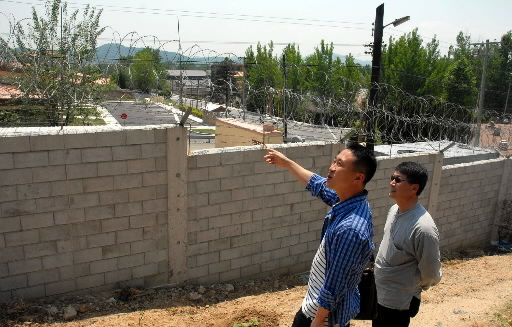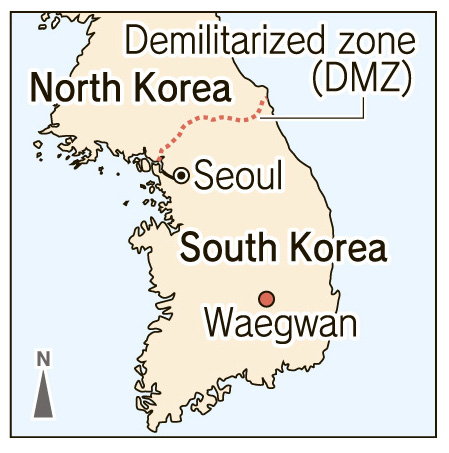Vietnam: 50 years after the use of defoliants, Part 2: Both victimizer and victim, Article 4
Jul. 24, 2012
Article 4: Suspicions of abandoned chemicals: South Korea
Statements by U.S. veterans: Farming town shaken
by Takamasa Kyoren, Staff Writer
Findings of U.S.-South Korea investigation: Questions raised
In Waegwan, a town in south central South Korea, a small industrial complex and greenhouses where grapes and melons are grown dot the landscape. The town, whose population is about 30,000, has been shaken by the issue of defoliants.
“Buried at the base”
There are suspicions that defoliants were abandoned on Camp Carroll, a supply base for the United States in South Korea. On a televised news program in May of last year, three former U.S. soldiers who were stationed at the base in the 1970s stated that they buried drums containing defoliant on the base after the Vietnam War (1960-1975).
“It’s hard to believe this sort of major issue has come up more than 30 years after the end of the war,” said Kim Sun Woo, 38. Mr. Kim is a member of a task force that is trying to uncover the facts behind the suspicions of abandoned chemicals on the base. Fifty-two groups, including peace organizations and labor unions, joined forces and asked the government of South Korea to take action. Since last October, members of the task force have conducted a survey of the health of about 5,000 residents of the area around the base.
The three U.S. military veterans stated that they worked at Camp Carroll as heavy equipment operators for the Army for one year, starting in February 1978. In the summer of that year their unit was ordered to use bulldozers to dig a hole approximately 9 meters wide and 9 meters deep on the base and to bury drums in it. They stated that most of the drums were rusty and leaking. Some of the defoliants were labeled “Agent Orange” and “Republic of Vietnam,” the former name of South Vietnam, they said. Agent Orange is highly toxic.
Mr. Kim characterized the veterans’ statements as very detailed and highly credible.
After the whistle-blowing, the U.S. government immediately embarked on a joint investigation with South Korea. It is believed that one reason for the probe was to quell discontent among local residents. In the course of the investigation, metal detectors were used to determine whether or not drums were present, and the soil and groundwater were tested. People who were employed on the base at the time were interviewed, documents were examined, and inspections were made in the presence of the American veterans who made the allegations. The final report was released in December of last year.
The report stated that herbicides other than Agent Orange and other chemicals had been buried but that the drums had been dug up and transported to the U.S. Trace amounts of dioxin were detected in the soil and groundwater, but the report said it could not be said that this was the result of defoliants and there were no effects on people’s health. This conclusion almost completely contradicted the statements by the veterans.
Father Koh Jin Seok, 38, a priest at the Waegwan Benedictine Monastery, is a member of the task force on defoliants. “It is very likely that there were high levels of contamination at the time the drums were buried,” he said. “It’s also unclear how much of what was disposed of. They are just trying to cover up the facts and put the matter to rest with this perfunctory investigation. It’s possible that there are similar problems at other bases.”
Also used in DMZ
During the Vietnam War defoliants were also used in the demilitarized zone (DMZ), which separates North and South Korea. No thorough investigation has been made into that matter either.
Jong Inchul, 32, is a member of Green Korea United, a Seoul-based non-governmental organization that pursues the issue of environmental damage caused by military bases. Mr. Jong took me to the vicinity of the DMZ. “Even the facts that could serve as a basis for compensation for damages are fuzzy,” he said. “The government has a responsibility to clarify the facts and address the situation.”
While covering this issue in the U.S. and South Korea I met people who are suffering from the effects of defoliants. The governments of both countries pay a certain amount of compensation to victims, primarily veterans. But most civilians as well as the children and grandchildren of victims remain ineligible. I was reminded again of the tremendous extent of the harm inflicted on Vietnam and the inadequacy of the aid that has been offered. The absurdity of war goes on.
(This is the last article in Part 2 of this series.)
(Originally published on July 6, 2012)









